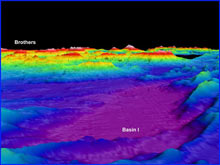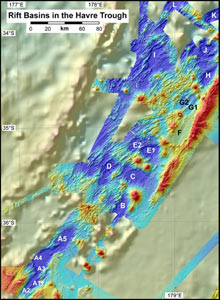A view of Basin I, one of the deepest basins in the Havre Trough with a depth of more than 3,400 meters (m). This image looks toward the southeast with Brother Volcano at 1,200 m in the background, 2.5 times vertically exaggerated. Click image for larger view and image credit.
This map shows the location of several of the small rift basins in the Havre Trough (labeled A - L) that have been sampled by our conductivity-temperature-depth-optical (CTDO) system during the cruise. The largest is the Ngatoro Rift (A1 - A5), where we did five separate casts. Click image for larger view and image credit.
Bouncing Along in the Backarc
August 9, 2007
Cornel E.J. de Ronde
Geologist
GNS Science
Lower Hutt, New Zealand
With two-thirds of the cruise under our belt, we continue to have mostly lumpy seas that are often accompanied by sunny skies. The weather has prevented us from deploying the remotely operated vehicle (ROV) as often as we might like. But it has also provided us with more time to achieve another goal we have for this cruise — namely, exploring the deep basins of the Havre Trough backarc for signs of hydrothermal venting.
Northeast of New Zealand, the boundary between two large tectonic plates (the Pacific plate in the east and the Australian plate in the west) is marked firstly by a deep trench — the Kermadec-Tonga Trench. Here, the Pacific plate dives down beneath the Australian plate, a process know as "subduction." At some depth, perhaps 100 kilometers (about 50 nautical miles) or so, the heating of the Pacific plate begins to drive water off the subducting "slab," causing the overlying Australian plate to melt in the lower parts of the oceanic crust. Magma (molten rock) bodies are thus formed that periodically pierce the sea floor and construct the large volcanoes that form the active arc front along the Kermadec Arc. Brothers Volcano is a prominent example of this process.
Behind this chain of submarine volcanoes, in a region known as the backarc, the oceanic crust is thinned, much like chewing gum does when you stretch it. So it is not uncommon to find basins in the backarc of the Kermadec Arc that are quite deep, in fact commonly 3,000 meters (about 10,000 feet) and sometimes deeper! Because the crust is relatively thinner in these basins, the mantle underneath the crust is closer to the sea floor than it normally would be, so that magma bodies could also be closer. All of this stretching and thinning adds up to these deep basins being intriguing prospects for areas of higher-than-normal heat flow. When combined with the penetration of seawater beneath the sea floor, this increased heat flow may result in hydrothermal systems that form black smokers chimneys, as we have found in abundance on Brothers Volcano.
A number of these basins occur in the Havre Trough. We have deployed our conductivity-temperature-depth-optical( CTDO) system, "bristling" with sensors that can measure both physical and chemical properties of the seawater into many of these basins, labeled A, B, C, and so on in the accompanying figure. Some of the basins are shallower than others. F, for example, is nearer to the Kermadec Ridge and is filling with sediment from its steep slopes. Others, like I and D, are much deeper, with the deepest being the Ngatoro Rift basin, where CTDO stations were labeled A1 to A5. Within each basin, we have lowered the CTD to within 20 meters of the sea floor, then collected samples of seawater in the bottles on the rosette as we haul the CTD back to surface.
Analyses of these samples, both onboard and later onshore in laboratories, will enable us to determine if hydrothermal venting is indeed occurring inside these basins. These are early days, but until we have all the results in we are left wondering: What other secrets is the deep ocean going to give up to us during this expedition?
Sign up for the Ocean Explorer E-mail Update List.


















